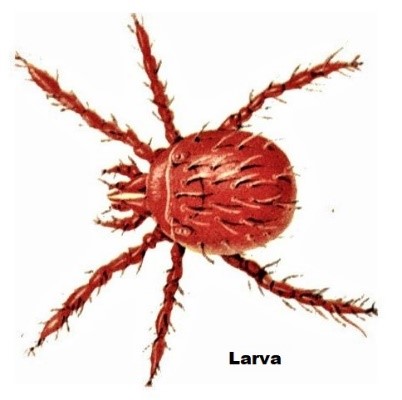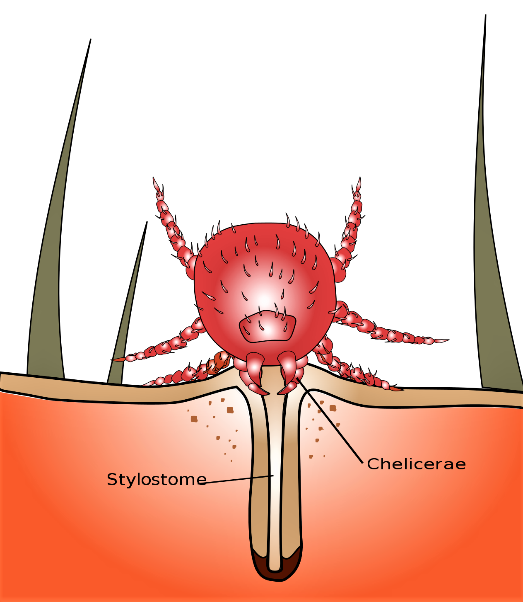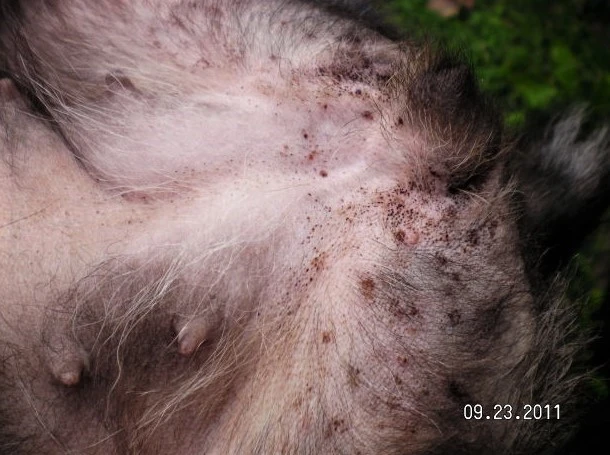By guest blogger, Vi Hummel Shaffer a 28-year veteran SAR/R K9 Handler specializing in K9 Forensic Human Remains Detection, an instructor, consultant, and speaker. She is the author of K9 Teams: Beyond the Basics of Search and Rescue and Recovery published by Brush Education.
Technically, chiggers are not insects – they are “arachnids” in the same family as spiders and ticks. Chiggers are also known by other names around the world: some call them berry bugs, red bugs, harvest mites, harvest bugs, harvest lice, mower’s mites, scrub-itch mites and others. Their scientific name is “trombiculidae mites” and there are approximately 30 species known to attack humans and other animals.
Where They Can Be Found
Chiggers like areas of high humidity. They live in every country around the globe except in high elevations or where it is too hot or dry. Fortunately, North American chiggers don’t seem to be carriers of major diseases unlike in East Asia and the South Pacific. In those areas’ chiggers can cause scrub typhus also known as Japanese river disease. This disease can cause fever, muscle pain, headaches, rash, gastrointestinal problems and coughing.
Chiggers live in damp areas such as grass – like fields, lawns, forests, along the edges of wooded areas, swamps, bogs, rotten logs and stumps, overgrown briar patches and other moist habitats near lakes and streams. However, although chiggers may be heavily concentrated in one spot, they can be virtually absent nearby areas.
When
Chiggers are most abundant when weeds, grass and other vegetation are substantial – usually in spring, summer and early fall when temperatures are in the 70s and 80s. But they avoid temperatures hotter than 99⁰F (37.2⁰C) and become inactive at temperatures below 60⁰F (15.5⁰C) and 42⁰F (5.556⁰C) will kill the biting ones.
Who and How They Attack
Only the larvae (baby chiggers) are parasitic! Nymph and adult stages do not “bite”. While adult chiggers average about 1/60 of an inch long (0.4mm) the larvae are only 1/100 to less than 1/150 of an inch (10.15 to 0.3 mm) in diameter. They are bright red, hairy, have six legs (larva pictured). Adult and nymph chiggers have eight legs. Some species of chiggers are yellow or straw-colored. After the chigger eggs hatch into larvae they don’t move very far by themselves. They congregate in groups on grass blades, low plants and bushes and small clumps of soil. They attach themselves to small mammals, birds, reptiles, rodents and humans (their least preferable host) who walk through the infested vegetation.

Larvae mites have claws that help them latch on to the host they choose – such as the shoes, clothing, fur/hair – and skin of animals. Generally, they crawl around and explore the host, sometimes for several hours, seeking a safe place before they feed. Bites can happen on any area of the body but mainly where there are folds, wrinkles or where skin in thinnest and easier to penetrate. Those areas are commonly where clothing is tight – around ankles at the sock line, around the waist, near the groin, behind knees, under the armpits – inconvenient places like panty lines, bra straps and there have been cases where they have made their way on to “private parts.” Chiggers can leave hundreds of bites on a host in just one exposure!
Prevention
Other than staying out of chigger infested areas – which isn’t always possible – searchers and those working in the field should wear long-sleeved shirts, tall boots with their trousers tucked into their socks and a belt to minimize chiggers’ ability to connect directly to skin under a shirt.
Insect repellent is also suggested. But even repellents that specifically state they repel chiggers may only afford some degree of protection. Over-the-counter insect repellent effectiveness usually lasts for several hours before needing reapplication. Those containing DEET (N,N-diethyl-meta-toluamide) may be applied directly to exposed skin but avoid getting it around or in the eyes. All repellents should be used according to label directions. If sunscreen is also used it should be applied first, rubbed into the skin and let absorb before using a repellent.
Long-lasting products such as those containing permethrin should only be sprayed on clothing (not on skin) and allowed to dry on the clothes for a couple of days before wearing. Permethrin sprays on clothing will remain effective even through a couple of washings. It is important to follow all label instructions. For double protection in heavily infested areas, it has been suggested to use repellent with DEET on your skin, and permethrin treated clothing. Sulphur powder applied to clothing has also been mentioned as providing some protection. But it has a horrible smell like rotten eggs.
Author’s Note: Being the recipient of thousands of chigger bites through the years, and although trying various repellents, I have found one thing that has truly lessened them. Bounce Dryer Sheets! I have used them for years, shared them with others in the field, and they have helped! Take two fresh dryer sheets and wrap them around each ankle – that’s two sheets per ankle – under your socks. I also tuck some in my waistband and then sprayed myself with repellent. I don’t know if the “fragrance free” sheets or if any other brands work since I have only used the scented Bounce sheets.
“Bite”

As previously stated, the larvae, not the adults or nymphs, are what does the damage. Chiggers don’t really bite nor do they “suck blood” or burrow into the skin. The larvae have tiny, sharp mouthparts that pierce the skin – poking a hole where they inject saliva containing digestive enzymes. Those enzymes break down and liquefy skin cells causing the human immune system to respond by hardening the cells all around the hole creating a hard feeding tube structure (referred to as a “stylostome”). It is through that tube that chiggers gain access to the digested skin cells where they constantly secrete saliva to liquefy new tissue. The larvae continue to feed sucking up the fluid until they are engorged. The enzymes are what causes the intense, relentless itching that begins several hours after the initial bite.
Because of the delay between the actual puncture and the itch, the host may not at first, associate it to their exposure to chiggers. The result of these bites will be clusters or groups of red pimple-like bumps or blisters whose itching usually peaks around 24 – 48 hours after the original piercing. Chigger larvae typically feed for three days before dropping off to find a place to digest their meal and molt into their next stage of life.

After Exposure: Clothing, shoes, gear (and dog) should be thoroughly brushed off immediately upon returning from the field. Once home, that clothing should be isolated from the rest of the laundry then washed in hot, soapy water. Boots should be left outside until cleaned. Dog bedding or vehicle kennel pads should also be cleaned.
A hot shower or bath should be taken as soon as possible with repeated soaping and vigorously scrubbing with a washcloth to dislodge any larvae that remain on the body. Although some chiggers may be forced off, the itching from the enzymes in the “tube” will still exist.
Some information sites suggest a cold shower should be taken, rather than hot, to help reduce inflammation from the bites and help relieve itching.
What to Do/Human Treatment (Note: This treatment information is a compilation of ideas from reputable sources. It is not medical advice.)
First of All, Don’t Scratch. Scratching can cause a secondary infection.
Don’t put clear fingernail polish on the bites to try to “suffocate” the chiggers. The chiggers may already be gone. Remember it is the enzymes already in your skin that cause the itching.
Don’t put bleach on the bites it doesn’t work!
All itch relief remedies provide only temporary relief. The following suggestions are the most authoritative.
Unfortunately, No one remedy works equally well for most people and, even less encouraging it can take two to three weeks for chigger bites to heal!
Rubbing alcohol will burn when it touches a wound but it may have a little benefit and possibly kill any larvae if they are still attached.
Hot (or cold) showers and baths
Cold bath with a few scoops of colloidal oatmeal
Cold compresses
Applying wrapped ice to the bites
Over-the counter anti-itch creams, ointments and sprays. If any contain hydrocortisone, consult with a doctor before using on children under the age of 12, or if pregnant or nursing.
Calamine or Pramoxine lotions
Menthol ointments (Vicks VapoRub)
Apple cider vinegar
Antihistamine pills such as Benadryl
Analgesics (pain relievers) may provide itch relief.
Ground up aspirin paste or baking soda paste applied to each bite.
Camphor Oil
In addition, antiseptic ointment will help prevent infection for bites that have been scraped by clothing or scratched. For severe cases of chigger bites a physician should be consulted. Steroid shots may be prescribed to alleviate the itch and if infected, antibiotics may be needed.
Chiggers on Dogs
Although a dog’s fur can protect it from some chiggers they still latch on to other areas. Those less hair-covered places such as around the dog’s eyes, ears, legs and stomach are particularly vulnerable. Once on-board they will crawl around and also climb around down into the fur looking for a good, safe place to feed.
Chiggers or Fleas
Fleas prefer warm-blooded hairy animals. They can jump eight inches high and thirteen inches horizontally. Fleas feed on blood so there may be some “flea dirt” (dried blood from bites) present on the dog’s body as can be seen in this photo. There are usually three or four bites lined up in a row in an area. They are small red bumps with a halo-like ring around them.

Chigger bites are in large, random clusters and look similar to small pimples, welts, blisters or hives.

Sometimes chiggers can be identified by observing what looks look like paprika on the dog’s fur. Those almost microscopic reddish dots are larvae.
Indications of Chiggers on Dogs
Intense itching/scratching – typically starts three to six hours after exposure – that lasts for days is the most apparent indication. While not all dogs react with itching, some may develop an allergic reaction with hives or facial swelling. As with humans, the itching enzymes will remain although the larvae will fall off after feeding for three or four days.
Clusters of Small, red crusty pimples, welts/bumps on skin which occur after several hours.
Red patches on exposed skin (can even be visible under their hair).
(If unsure of what the problem is, since other skin conditions may cause bumps, consult a veterinarian who can make the diagnosis.)
Treating Chigger Bites on Dogs
As previously mentioned, the dog should be brushed/wiped off immediately after returning from the field. It is recommended a soft cloth or vet-approved skin wipe be used around the sensitive areas. Chiggers can also infect a dog’s inner ear.
There are products/shampoos on the market to treat chigger bites on dogs but it is important to review them for safety and results. There are home-remedies (with mixture directions online) which may or may not be effective such as: bathing the dog in Epsom salts, a warm Colloidal Oat or Brewed Green Tea bath, Wrapped Ice Packs or Cold Compresses. Before using human treatments, a veterinarian should be consulted. The Vet may prescribe anti-parasitic sprays, dips, topical medication or suggest an antihistamine. In cases of severe infestation steroids may be prescribed. Remember continuous scratching can develop into bacterial infection which then would require antibiotics.
Prevention Veterinarian approved, dog medications for killing ticks and mites (Frontline, NexGard, Seresto, etc.) may help fend off chiggers. If chigger infested areas are within the dog’s home territory – Keep the dog away from them for about two weeks while those places are treated with pet-safe products.
Chiggers and the Ecosystem
After much research, due to curiosity about the “benefits” of chiggers, the most learned is that they feed on different foods at their different life stages. Larvae are parasitic while nymphs and adults feed only are various plant materials and smaller arthropods in the soil. Natural predators of chiggers (and other mites) are spiders, beetles, birds, lizards, centipedes, salamanders, certain species of ants and other small creatures which live in areas populated by chiggers.
Note from Susan: While this article applies to people and dogs, chiggers can bite cats and other animals as well.